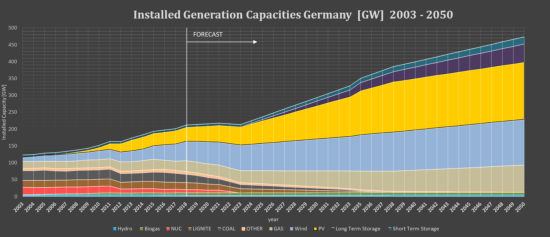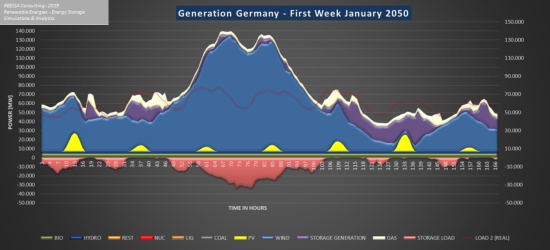




© REESSA Consulting UG (haftungsbeschränkt) 2019
IMPRINT

Energy Storage
REESSA Consulting is an independent engineering company for energy storage technologies. We offer technical and economic consulting services for energy storage projects. Our primary experience involves consulting in the field of pumped storage technology. We offer services encompassing all phases of development from proof of concept through to operation alongside our economic forecasting models. Our experience and analysis results in the field of pumped storage technology have also been transferred to other storage technologies. From battery storage for private PV storage to forecasting models for a supranational full supply from renewable energies using power-to-gas long-term storage (P2G). We expect enormous growth opportunities, especially in the battery storage sector, but also in the P2G sector in the long term. REESSA Consulting offers complex market analyses and forecasting models for energy storage systems. Our goal is to develop optimal, long-term and sustainable investment models.
Range of Services
• Hydro Pumped Storage Technology • Battery Storage Technology • Hydropower Energy Storage Reservoirs • Power-to-Gas • Feasibility Studies • Technical Assessments • Cost Calculation • Revenue Calculations • Profitability Analyses • Optimized Operation • Market Analyses / Market Forecasts • Forecast Models for Energy Storage Systems • Virtual Pumped Storage Power Plant • Capacity Expansions • Increased of Performance • Flexibilization • Control Energy (Prim/SEK/MIN) • Intelligent Investment • Power Plant Optimization • Storage Demand Analysis • Black Start ServicesFuture
Energy
Systems
Requires
High Capacities of Energy Storage
Energy storage systems are the key technology of future energy systems. From a share of more than 40% of renewable energies in net electricity generation, the demand for energy storage systems increases significantly. This figure was already exceeded in the German electricity market in 2018. The goal of the German Federal Government to achieve a share of over 80% of renewable energies in electricity generation by 2050 requires a significant expansion of the installed capacity of energy storage systems compared to today's storage capacities. Short-Term and Long-Term Storage Energy storage systems can basically be divided into short-term and long-term facilities. Short-term storage facilities such as pumped storage power plants have been operating commercially on the market for over 80 years. The demand for both types of storage will increase significantly over the next 30 years. The share of long-term storage (10h - 200h full load hours) will be of decisive importance for achieving the goal of a 100% supply from renewable energies. But also, the share of short-term storage (<10h full load) will grow continuously.A Turning Point for Energy
Storage
The turnaround on the energy storage market has already begun. Up to now, it has been possible to almost completely integrate renewable energies into the existing grid structures and a conventional power plant fleet with ever greater flexibility. The ever- decreasing share of conventional power plant capacity, the complete phase-out of nuclear energy by 2023 and the drastic dismantling of lignite and hard coal capacities planned for the next few years in Germany, will cause demand for peak-load power plants to rise significantly again. In other words, the price of electricity and with it the price spread will rise again. On the other hand, an ever-increasing supply of renewable energies will lead to ever more frequent periods of very low and negative residual loads. The current electricity market system therefore still reacts with negative electricity prices (mid Europe) , as a non-negligible base load is not or must not be taken off the grid for commercial and technical reasons.
Renewables Energies
Energy Storage
Simulations & Analytics

Previous Problem of Profitability
Although industry, politics and science have been calling for the necessity of expanding energy storage for years, the real market conditions for storage have become increasingly difficult since the mid-2000s. In particular, the so-called price spread, the difference between the high price and the low price on the energy market, declined for many years. As a result, some pumped storage power plants could no longer be operated economically. For example, one of the world's oldest commercially operated pumped storage plants, the PSP Niederwartha near Dresden, has only been in transition operation since 2016. Various plans in Germany and Europe for new construction projects were stopped, as economic viability could no longer be proven. The reason for this development was and is the enormous oversupply of installed capacity. The electricity price had fallen to a historic low in 2016. The share of renewable energy rose to over 40% in 2018. Peak-load power plants, which in addition to pumped storage power plants also included gas-fired power plants, were required less and less due to the large share of renewable energies. For this reason, the installed capacity of conventional power plants was reduced further and further.
The share of energy storage in the energy market will experience high growth rates in the future
HOME








Change in the Energy System
Energy systems around the world are in a phase of major restructuring. The long- term goal of operating energy systems with a 100% renewable energy supply requires a significant expansion of energy storage facilities. Up to a share of approx. 40% in electricity generation, larger energy grids can integrate the share of renewable energies almost completely into the grid operation without the need for significant storage capacities. A larger share of generation from renewable energies makes the operation of energy storage facilities not only economically but also technically necessary.
Future generation mix in winter with high storage demand for excess wind power


Future generation mix in summer with high photovoltaic shares


DE|EN|
